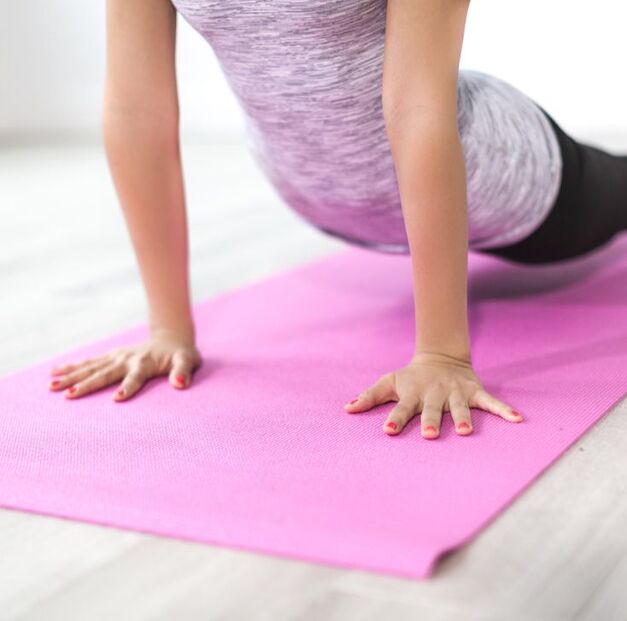|
This article was reprinted on ProHealth in 2017. It was later removed for reasons outlined in this notice. Most of the links on this post are informational, but a few are affiliate links to help maintain this website. Last week I went to a yoga class with a plank sequence that went on for twenty minutes. While the rest of the class did low plank, high plank, side plank, and one-legged plank, I was in child's pose. There were at least two people in the class over seventy-five who seemed to have no problem with the planks. At first I was embarrassed being folded up in a little ball while the others were sweating through their gym clothes, but then I remembered—my challenge was just in getting there. When I walk into a yoga studio there is no indication from my outward appearance I’ll be the one in child's pose half the class. I'm usually one of the youngest people in the class. The reason I struggle is because, in addition to Lyme, I have an autoimmune condition called SAPHO Syndrome. It's a type of reactive arthritis that attacks my muscles, joints, and bones. Over time, this extremely rare illness caused fusion in my lumbar spine and sacral joints. I also have fusion in my clavicle, limiting the range of motion in my shoulders. I'm lucky if I can just touch a block in forward fold. SAPHO also causes chronic pain. In spite of my physical limitations, I will never stop going to yoga. For me, the positives far outweigh the negatives. I fell in love with yoga, when I bought a DVD called Yoga Conditioning for Weight Loss to get in shape for my wedding 10 years ago, but it was only after I became ill that I truly understood the benefits of regular practice. When I'm in yoga class, I am at peace. My sympathetic nervous system, or "fight or flight" reflex shuts down and puts me in the healing state of regulation. It's the only type of exercise I feel comfortable doing with my condition, because I don't have to worry that it will put a strain on my already taxed immune system. Yoga also helps me maintain the range of motion I still have, and hopefully will help me gain some back. With regular practice I'm able to inch the tiniest bit closer to touching my toes. In addition to adding flexibility, the stretches ease and prevent pain. Like many people with Lyme and related autoimmune disorders I also have chronic fatigue, which means most days I don't have the energy to go to yoga and after I finish class, I'm exhausted. I usually only make it to one or two classes a week. It takes a lot of motivation to get myself to go, but when I'm done I feel so accomplished--exhausted--but accomplished. I used to worry that the teacher or other students would think I was lazy or not trying, but through yoga I've learned to listen to myself. Now, I don't worry about what other people think, and simply do what my body tells me it needs. For other people with limitations who have been considering yoga, I encourage you to try it. There are chair, gentle, restorative, and slow flow classes at most gyms and studios. These classes are designed for beginners or those of us who need to take it easy. You can slowly work your way up to the next level. For those of you who are intimidated by a group class, private sessions may be an option. There are also certified yoga therapists, who meet individually with clients and use yoga poses and breathing techniques to treat emotional and physical ailments. It's also important to note that using pose modifications and props help you get the most out of your practice. Don't be ashamed to use a block or a strap—even the most experienced yogis use them to deepen poses. When I reach my limit, I simply go into child's pose and rest. Make sure you communicate your physical restrictions with the instructor before class. At the end of each class when I bow to the teacher and my classmates and say, "namaste," in my head I always say the translation, "the divine in me blesses and honors the divine in you." We're all sacred beings, and no one in any yoga class is better than anyone else based on ability or flexibility. What's important is showing up and listening to your body. Remember, honoring yourself is the honoring the divine. "Yoga is not about touching your toes, it is what you learn on the way down." - Jigar Gor
1 Comment
Crys
11/13/2017 12:34:11 am
I'm sorry it's been a while since I responded. A lot has been going on lately.
Reply
Leave a Reply. |
WelcomeI'm Kerry (She/Her/Hers) and I am a licensed therapist, group facilitator, poet, writer, & speaker. This is a place to acknowledge and validate our suffering and trauma, while also learning how to turn toward aliveness and spaciousness. Categories
All
Archives
April 2024
|
|
Copyright © 2024 Kerry J Heckman All rights reserved. Disclaimer.
|
|



 RSS Feed
RSS Feed